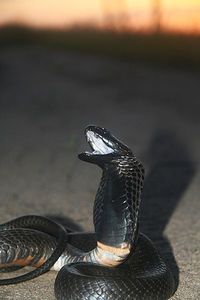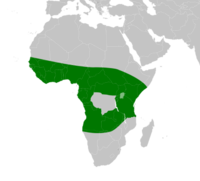Black-necked spitting cobra
| Black-necked spitting cobra | ||||||||||||||||||||
|---|---|---|---|---|---|---|---|---|---|---|---|---|---|---|---|---|---|---|---|---|
 Black-necked spitting cobra
| ||||||||||||||||||||
| Scientific classification | ||||||||||||||||||||
| ||||||||||||||||||||
| Binomial name | ||||||||||||||||||||
| Naja nigricollis Reinhardt, 1843[1][2] | ||||||||||||||||||||
 Distribution of the black-necked spitting cobra
| ||||||||||||||||||||
| Synonyms | ||||||||||||||||||||
|
The black-necked spitting cobra (Naja nigricollis) is a species of spitting cobra found mostly in sub-Saharan Africa. They are moderately sized snakes that can grow to a length of 1.2 to 2.2 m (3.9 to 7.2 ft) in length. Their coloration and markings can vary considerably. They prey primarily on small rodents. They possess medically significant venom, although the mortality rate for untreated bites on humans is relatively low (~ 5-10%). Like other spitting cobras, they can eject venom from their fangs when threatened. The venom irritates the skin and can cause permanent blindness if it enters the eyes.
The black-necked spitting cobra' belongs to the cobra genus Naja under the family Elapidae. It previously included two subspecies that have been moved to the species Naja nigricincta - the zebra spitting cobra (Naja nigricincta nigricincta) and the black spitting cobra (Naja nigricincta woodi).
Taxonomy and etymology
Naja nigricollis is classified under the genus Naja of the family Elapidae. It was first described by Norwegian zoologist Johan Reinhardt in 1843. The generic name Naja is a Latinisation of the Sanskrit word nāgá (नाग) meaning "cobra". The specific epithet nigricollis is Latin for "black-necked": niger meaning "black" and collis meaning "neck".[3]
Naja nigricollis previously included two subspecies - Naja nigricollis nigricincta and Naja nigricollis woodi. But genetic studies in 2007 by Wolfgang Wüster et al. have concluded that these subspecies should be treated under a separate species, Naja nigricincta.[4]
Description
N. nigricollis is a moderately sized, venomous snake with a moderately distinct head; the shape of the head is due primarily to two large venom glands found on each side of the head. Its colour can vary depending on region of origin. Some specimens are black or pale grey with a yellow or reddish ventral side with a broad, black neck band, often with an orange or pinkish bar on the neck. Other specimens can be yellowish-brown or have a yellow copper colour and are missing the bandings around the neck and the reddish colour on the belly. Some other specimens are deep reddish-brown, and yet others can be an olive brown.[5] Some can even be striped black and white.[6] There are 21-23 dorsal scales at the mid-body, 182-196 ventral scales, and 54-66 subcaudal scales.[7] This species generally grows to a length of 1.2 m (3.94 ft) to 2.2 m (7.22 ft). These sizes are subject to trends based on geographic location and subspecies.
Distribution and habitat
Geographical distribution
The species is very common and is widespread throughout sub-Saharan Africa and is found in western, eastern, central, and southern Africa. It can be found all along eastern Africa south of the Sahara Desert in Kenya, Uganda, Tanzania, Rwanda, and southern Somalia. It is found in Nigeria, Liberia, Senegal, and Benin in western Africa. It is common in Zambia, Central African Republic, Angola, and Cameroon in central Africa. In southern Africa, it is found in the northern parts of Zimbabwe, Botswana, Namibia and Mozambique.[5]
Habitat
The black-necked spitting cobra usually inhabits savanna and semidesert regions of Africa. However, they can be found at altitudes up to 1800 m (5905.51 ft), as well as in tropical and subtropical regions of central Africa in moist savanna and cleared former forest regions, particularly near rivers and streams.[8] Adaptable snakes, the black-necked spitting cobra occurs in southeastern Nigeria where their habitat has been transformed from rainforest to man-made farmlands, plantations, suburban areas, and a few fragmented forests. This species of cobra has found advantages in the drastic changes which have taken place in Nigeria's rainforests. A study by herpetologist Luca Luiselli, suggests this snake now forages in much drier microhabitats.[9]
The range of the black-necked spitting cobra is currently expanding from the southeastern regions of Nigeria to the more desert and arid conditions in the central part of the nation.[7] They also live in coastal scrubs and dry grasslands. Like other cobra species, they may find abandoned termite mounds or rodent holes to hide or cool off. However, tree trunks seem to be their favourite hiding places. They are excellent tree climbers, thus can be arboreal at times. Because they are so common across Africa, they are encountered in villages or small towns where they may come in direct contact with people.[7]
Behaviour and ecology
Unlike other snakes, the black-necked spitting cobra can be either nocturnal or diurnal depending on the time of year, geographic location, and average daytime temperature. This adaptability allows the snake to better regulate its body temperature and to gain access to the most abundant food sources of a particular area. It feeds primarily on small rodents, such as small rats and mice, but will eat lizards, eggs and other snakes.[10]
Like other snakes, it may fall prey to different birds of prey, especially different species of snake eagles which migrate to Africa when it is winter in the Northern Hemisphere. The short-toed snake eagle (Circaetus gallicus) may be a particular threat, as it is almost strictly an ophiophagus raptor.[11] Other snakes also prey on this species.[12]
Like other spitting cobras, this species is known for its ability to project venom at a potential threat. The venom is an irritant to the skin and eyes. If it enters the eyes, symptoms include extreme burning pain, loss of coordination, partial loss of vision and permanent blindness. This species is known for its tendency to liberally spit venom with only the slightest provocation. However, this aggressiveness is counterbalanced by it being less prone to bite than other related species.[8][10]
This species is sometimes found in captivity, and wild-caught individuals are generally nervous and prone to spitting. Captive-bred animals tend to be much more docile and calm when compared to their wild-caught counterparts.[5]
Reproduction
Like other cobra species, this snake is oviparous.[13] The mating season of this species can vary from the end of winter (September) to the beginning of summer (December). Usually, the mating season is the same whether in captivity or in the wild. Females will usually lay 10 to 15 eggs, but they can lay anywhere between eight and 22 eggs at a time.[12] The gestation period lasts about 90–100 days, but once the eggs are laid, they hatch in 60–70 days, and need to be in a temperature of 28-30°C (82.4-86°F). At birth, the young are about 20 to 25 cm (7.9 to 9.8 in) in length and are completely independent.
Venom
The venom of black-necked spitting cobra is somewhat unique among elapids in that it consists primarily of cytotoxins,[14] but with other components also. It retains the typical elapid neurotoxic properties while combining these with highly potent cytotoxins (necrotic agents)[15] and cardiotoxins.[16] Bite symptoms include severe external hemorrhaging and tissue necrosis around the bite area and difficulty breathing. Although mortality rate in untreated cases is low (~ 5-10%),[17] when death occurs it is usually due to asphyxiation by paralysis of the diaphragm. The LD50 of the black-necked spitting cobra is 2 mg/kg by subcutaneous injection and 1.15 mg/kg by Intravenous injection. The average venom yield per bite of this species is 200 to 350 mg ( dry weight ) according to Minton (1974).[8][18]
Cited references
- ↑ Naja nigricollis (TSN 700633) at Integrated Taxonomic Information System. Accessed 10 May 2012.
- ↑ Naja nigricollis REINHARDT, 1843 at The Reptile Database. Accessed 10 May 2012.
- ↑ Reinhardt, J; Andreas Johann Wagner, Franz Hermann Troschel, Wilhelm Ferdinand Erichson, Carl Ernst Siebold (1847). “Herpetology”, Reports on zoology for 1843, 1844. Ray Society.
- ↑ Wüster, W., S. Crookes, I. Ineich, Y. Mane, C.E. Pook, J.-F. Trape & D.G.Broadley (2007) "The phylogeny of cobras inferred from mitochondrial DNA sequences: evolution of venom spitting and the phylogeography of the African spitting cobras (Serpentes: Elapidae: Naja nigricollis complex)". Molecular Phylogenetics and Evolution, 45: 437-453.
- ↑ 5.0 5.1 5.2 Mastenbroek, Richard. Black-neck Spitting Cobra. DEVENOMIZED. www.devenomized.com. Retrieved on 10 May 2012.
- ↑ Kraits Cobras Sea Snakes and Relatives: Elapidae - Black-necked Spitting Cobra (naja Nigricollis): Species Accounts. Retrieved on 10 May 2012.
- ↑ 7.0 7.1 7.2 Abriol, Sabrina. Spitting cobra (Naja nigricollis). Herpetology - Dr. Dever. University of San Francisco, California. Retrieved on 10 May 2012.
- ↑ 8.0 8.1 8.2 Naja nigricollis - General Details, Taxonomy and Biology, Venom, Clinical Effects, Treatment, First Aid, Antivenoms. WCH Clinical Toxinology Resource. University of Adelaide. Retrieved on 10 May 2012.
- ↑ Luiselli, Luca (2001). "The ghost of a recent invasion in the reduced feeding rates of spitting cobras during the dry season in a rainforest region of tropical Africa". Acta Oecologica 22 (5): 311–314. DOI:10.1016/S1146-609X(01)01113-4. Research Blogging.
- ↑ 10.0 10.1 Spawls, Stephen (1995). Dangerous Snakes of Africa. London, UK: Blandford Press. ISBN 0713723947.
- ↑ Bauchot, Roland (2006). Snakes: A Natural History. New York, USA: Sterling; illustrated edition edition, 176. ISBN 1402731817.
- ↑ 12.0 12.1 FitzSimons, Vivian FM (1970). A field guide to the snakes of Southern Africa. Canada: HarperCollins. ISBN 0002121468.
- ↑ Engelmann, Wolf-Eberhard (1981). Snakes: Biology, Behavior, and Relationship to Man. Leipzig; English version NY, USA: Leipzig Publishing; English version published by Exeter Books (1982), 71. ISBN 0-89673-110-3.
- ↑ Marais, Johan (2004). A Complete Guide to the Snakes of Southern Africa. Cape Town, South Africa: Struik Nature. ISBN 186872932X.
- ↑ Chaim-Matyas, Adina; Ovadia, Michael (20). "Cytotoxic activity of various snake venoms on melanoma, B16F10 and chondrosarcoma". Life Sciences 40 (16): 1601–1607. PMID 3561167.
- ↑ Fryklund, Linda; Eaker, David (July 1975). "Complete covalent structure of a cardiotoxin from the venom of Naja nigricollis (African black-necked spitting cobra)". Biochemistry 14 (13): 2865–2871. PMID 1148181. Retrieved on 10 May 2012.
- ↑ Warrell, David A.. Snake bite. Seminar. Lancet 2010 (volume 375, issue 1). Retrieved on 10 May 2012.
- ↑ Fry, Dr. Bryan Grieg. LD50 for various snakes. Australian Venom and Toxin database. Venom Doc. Retrieved on 10 May 2012.